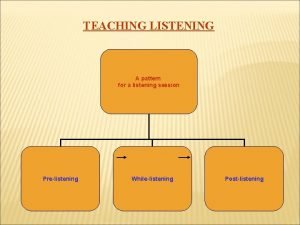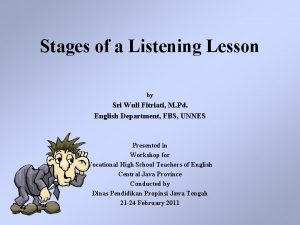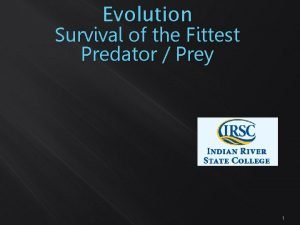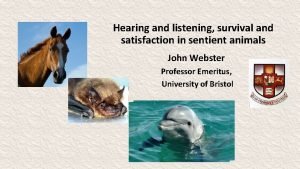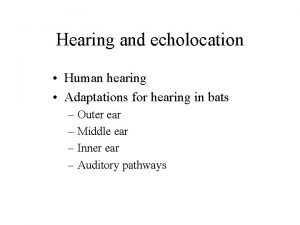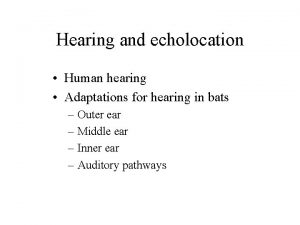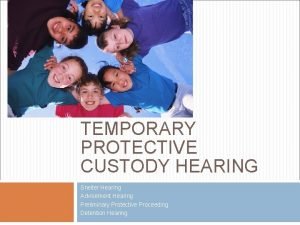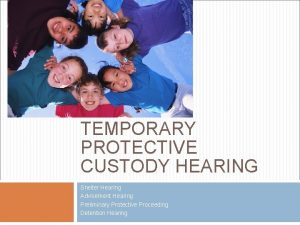Hearing and listening survival and satisfaction in sentient



















- Slides: 19

Hearing and listening, survival and satisfaction in sentient animals John Webster Professor Emeritus, University of Bristol

Sound: definitions • ”If a tree falls in the forest does it make a sound if there is nobody there to hear? ” • Physical • Oscillation in pressure, particle displacement, particle velocity, etc. , propagated in a medium (i. e. air, water, solids) i. e. YES • Physiological • Auditory sensation evoked by the oscillation described above: i. e. NO

Lower limits to audio frequency range

Upper limits to audio frequency range

Darwinian fitness: survival and successful reproduction • Achieved through behaviour appropriate to the phenotype. Musk ox House mouse

Animal communication by sound • to identify a specific individual or location • to locate the specific individual or individuals to whom a message is to be conveyed • to convey a specific message • to avoid, where possible, alerting predators. • (language seldom, if ever, necessary)

Crow using tools

”What is important? ” – priorities for fitness Outcomes - survival, - reproductive success, Motivation - survival (hunger, thirst, security) - avoidance of pain and distress - satisfaction (physical and mental wellbeing) - (pleasure)

Strategies for success • Survival and security – eat and be not eaten • Predators – prey location • Prey – alarm calls, “secret messaging” • Reproduction • Mating • Bonding • Child rearing • Social communication • Security • Companionship

Prey location: owls Owls with asymmetrically placed ears can calculate elevation and horizontal angle of a sound source (e. g. mouse)

Prey location: bats

Echolocation: whales and dolphins • Clicks in the (human) audiofrequency to locate prey, depth of water, holes in the ice etc. • (distinct from “singing”)

Prey behaviour • Alarm calls • More warning than fear – promote safety of family/social group • Chimpanzees, vervet monkeys (and domestic hens) have threat-specific sounds • snake – look down, eagle –look up • “Secret messaging” • Mice communicate alarm calls in ultrasound (audible to cats? )

Strategies for success: 2. • Survival and security – eat and be not eaten • Predators – prey location • Prey – alarm calls, “secret messaging” • Reproduction • Mating • Bonding • Child rearing • Social communication • Security • Companionship • “Pleasure? ”

Bird song • Mating • Sexual selection: attracting females and competition with other males • in temperate zones with predictable breeding seasons, males sing (mostly). In tropical and desert zones both sexes sing. • Bonding • ”Duetting” strengthens bonds and increases reproductive success: (quail, some owls) • Child rearing • Father birds teach their offspring to sing (which is how they can acquire regional accents)

Other mating calls. • Singing whales • Rutting and lecking in stags • “Bulling” calls by cows in oestrus.

Parent/offspring communication “keep safe and don’t get lost” • Distinctive alarm calls in birds: Parents introduce chicks to alarm calls while still in the egg • Dolphins have “signature whistles” • Ewes can recognise their lambs by sound (and sight) among >200 others

Social communication (outside the immediate family) • Security • Alarm calls (primates) • Companionship • Wolf calls (extended families) • Pleasure • Cello and the nightingale? • Why do cats purr?

Summary and conclusions • Sentient animals selectively listen to the sounds that they identify as important because they convey information relevant to their needs to achieve security, satisfaction and reproductive success. • Clear evidence that sentient animals express signs of pleasure • But can they enjoy music?
 Pre while post listening activities
Pre while post listening activities Pre listening stage
Pre listening stage Sentience
Sentience State of survival survival of the fittest tweak
State of survival survival of the fittest tweak State of survival survival of the fittest stages
State of survival survival of the fittest stages Listening barrier
Listening barrier Difference between hearing and listening
Difference between hearing and listening Discriminative listening
Discriminative listening Importance of listening skills
Importance of listening skills We listen
We listen Listening vs hearing
Listening vs hearing Factual distractions
Factual distractions Listening strategies
Listening strategies Listening vs hearing
Listening vs hearing Factual distractions
Factual distractions Listening vs hearing
Listening vs hearing Survival in the forest listening
Survival in the forest listening Active listening involves
Active listening involves Inferential listening
Inferential listening Chapter 42 hearing speech and vision problems
Chapter 42 hearing speech and vision problems
